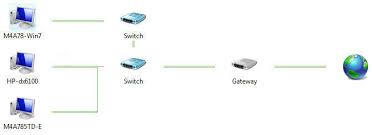In telecommunications, the term gateway has the following meaning:
- In a communications network, a network node equipped for interfacing with another network that uses different protocols.
- A gateway may contain devices such as protocol translators, impedance matching devices, rate converters, fault isolators, or signal translators as necessary to provide system interoperability. It also requires the establishment of mutually acceptable administrative procedures between both networks.
- A protocol translation/mapping gateway interconnects networks with different network protocol technologies by performing the required protocol conversions.
- Loosely, a computer or computer program configured to perform the tasks of a gateway. For a specific case, see default gateway.
Gateways, also called protocol converters, can operate at any network layer. The activities of a gateway are more complex than that of the router or switch as it communicates using more than one protocol.
Both the computers of Internet users and the computers that serve pages to users are host nodes, while the nodes that connect the networks in between are gateways. For example, the computers that control traffic between company networks or the computers used by internet service providers (ISPs) to connect users to the internet are gateway nodes.
In the network for an enterprise, a computer server acting as a gateway node is often also acting as a proxy server and a firewall server. A gateway is often associated with both a router, which knows where to direct a given packet of data that arrives at the gateway, and a switch, which furnishes the actual path in and out of the gateway for a given packet.
On an IP network, clients should automatically send IP packets with a destination outside a given subnet mask to a network gateway. A subnet mask defines the IP range of a private network. For example, if a private network has a base IP address of 192.168.0.0 and has a subnet mask of 255.255.255.0, then any data going to an IP address outside of 192.168.0.X will be sent to that network's gateway. While forwarding an IP packet to another network, the gateway might or might not perform Network Address Translation.
A gateway is an essential feature of most routers, although other devices (such as any PC or server) can function as a gateway.
Most computer operating systems use the terms described above. Microsoft Windows, however, describes this standard networking feature as Internet Connection Sharing, which acts as a gateway, offering a connection between the Internet and an internal network. Such a system might also act as a DHCP server. Dynamic Host Configuration Protocol (DHCP) is a protocol used by networked devices (clients) to obtain various parameters necessary for the clients to operate in an Internet Protocol (IP) network. By using this protocol, system administration workload greatly decreases, and devices can be added to the network with minimal or no manual configurations.
Internet-to-orbit gateway
An Internet to orbit gateway (I2O) is a machine that acts as a connector between computers or devices connected to the Internet and computer systems orbiting Earth, such as satellites or manned spacecraft. Such a connection is made when the I2O establishes a stable link between a spacecraft and a computer (or a network of computers) on the Internet, such links can be for control signals, audio frequency, or visible spectrum signals.
Project HERMES is the first project to have brought this kind of machine into operation. The HERMES-A/MINOTAUR Space Flight Control Center became operative on June 6, 2009 and was operated by representatives of 34 countries on the UNOOSA Symposium of Small Satellites for Sustainable Development in Graz, Austria on September 10, 2009. Project HERMES is an initiative of the Ecuadorian Civilian Space Agency and has a maximum coverage of 22,000 km, HERMES-A is supposed to be the first gateway of a network of five covering all South America. HERMES-A/MINOTAUR can transmit voice as well as data.
The Global Educational Network for Satellite Operations (GENSO) is an initiative from NASA and ESA, and is an example of an I2O.
Cloud gateway
A cloud storage gateway is a network appliance or server which resides at the customer premises and translates cloud storage APIs such as SOAP or REST to block-based storage protocols such as iSCSI or Fibre Channel or file-based interfaces such as NFS or CIFS. Cloud storage gateways enable companies to integrate cloud storage into applications without moving the applications into the cloud. In addition they simplify data protection.

